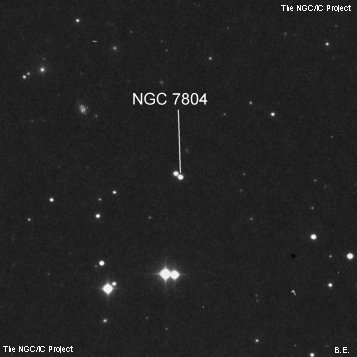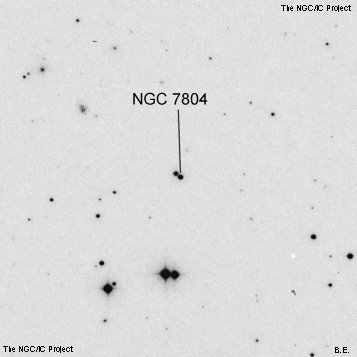NGC/IC Project Restoration Effort
(This is a very very beta version)
NGC7804


Basic Information
Location and Magnitude
Right Ascension: 0:1:18.8
Declination: +7:44:55
Constellation: PSC
Visual Magnitude:
Historic Information
Discoverer: Schweizer
Year of discovery: 1860
Discovery aperture: 9.0
Observational
Summary description: vF, D *, nebulous ?
Sub-type: *2
Corwin's Notes
=====
NGC 7804 is a double star. Dreyer, in a note in NGC itself, says that "von
Engelhardt in 4 obs could only see a D* without nebulosity." Once Burnham
turned the 36-inch at Lick on the object, the question was settled for Dreyer.
His IC1 note is quite firm: "To be struck out, only a F double star without
nebulosity (Burnham)." This is indeed what we see today.
Wolfgang has a short biography of K. Gottfried Schweizer, the discoverer of
this object. Briefly, Schweizer was director of the Moscow University
Observatory beginning when he found NGC 7804 in October of 1860. Though I
have not seen it, his observation, and a follow-up by the next director of the
Observatory, F.A. Bredikhin, are listed in the Moscow Observations, Vol. II,
book 2, pp 115 and 119. The story is on pp 232-233 of Wolfgang's 2010 book.
The telescope, by the way, was a 23-cm Merz refractor. It must have been
quite similar to the 9.5-inch Merz that Brother Ferrari was using at the
Roman College at about the same time (see NGC 7667).
Steve's Notes
=====
NGC 7804
18" (11/17/08): this 10" unequal pair of faint stars was resolved at 175x and easily split at 325x. Located 3' N of a pale orange/blue-white pair (Du 4 = 9.6/10.2 at 15"). A third mag 10 star lies just 1.4' ESE of the closer pair.
This erroneous NGC entry is from Schweizer (Observations de Moscou, II, 115). But in four observations Engelhardt could only see a double star without nebulosity and the region was carefully examined by Burnham (Publ of Lick Obs, II) on two nights and only a faint pair was found: "but there was no trace of nebulosity about it, or anywhere in the vicinity." He measured the separation (1891) as 9.8" in PA 55.6¡.



